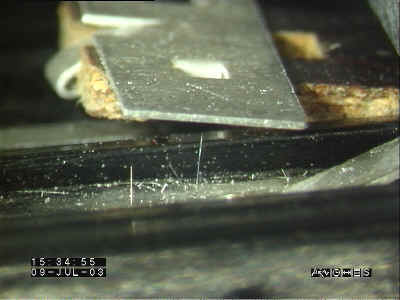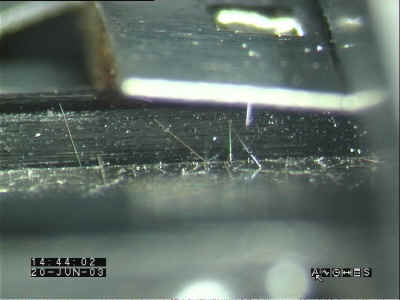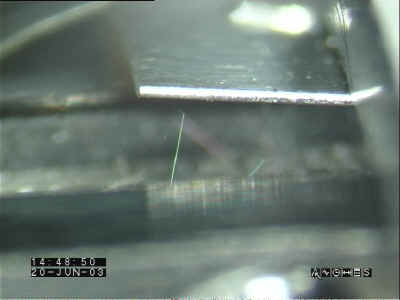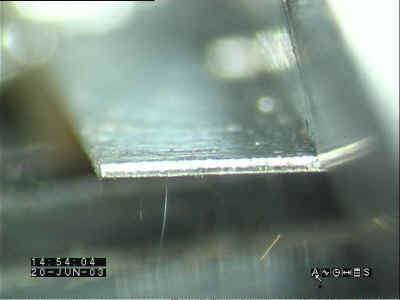Anecdote
#5: Field Failures Due to Tin Whiskers on "Bright"
Tin-Plated Circuit Breaker Contacts
Click on the Thumbnails Below
to see a Larger Version of the Picture |
|
Source:
Anonymous (Terrestrial Application)
Date: Field Failures
First Observed Circa 2003
The images below
depict tin whiskers growing on the "bright" tin-plated
copper contacts inside of a circuit breaker.
Two to three years after deployment of these components into (terrestrial) service,
the user began to experience field failures in multiple locations
across Europe. Failure analysis identified the root cause of failure
to be tin whisker induced short circuits across contact pairs that
are normally open circuit. During failure
analysis the user observed that the density and length of whiskers were
greatest in the
areas of the contacts exposed to highest electric field in operation (i.e., between the separated contact pairs
having 50V potential
difference). Read
More about this experience below.
|
Tin Whiskers Growing on "Bright"
Tin-Plated Copper Contacts Inside a Circuit Breaker |
|

|

|
|

|

|
The
procurement requirements for this
circuit breaker specified the contacts to have "reflowed" tin
finish over copper. Due to a purchasing/supplier error that spanned a
period of ~2 years, the user received a number of devices (such as those
depicted above) whose contacts were "bright" tin-plated, non-reflowed
over copper. Within 2 to 3 years of fielding the "bright"
tin-plated components, the user began to experience tin whisker induced
failures. Field conditions for this component are typically
air-conditioned spaces, but the component operates at 35°C to 40°C
average due to its location within the equipment rack.
The user
also reported the following interesting observations:
-
During normal
application, there is a 50V bias across the open circuit contacts. In
the "biased area" where the electric field is highest, the
tin whisker lengths reached in excess of 2 - 4 mm which is
sufficient to bridge the gap between the separated contacts resulting
is device failure. One picture
shows a tin whisker that is bending where it is squeezed between the separated contacts.
-
Tin whiskers were also
observed in areas away from the biased region, but the density and
maximum lengths were significantly less (~1 mm maximum) than found in
the biased regions.
-
Tin whiskers were also
found on spare parts taken from inventory (i.e., warehouse storage,
unbiased) having the same lot date codes as the field failures.
Whisker lengths for the parts taken from inventory were much shorter and whiskers were more randomly distributed
(i.e., not
more prevalent in the gap areas).
-
Based on observations
1, 2, and 3 the user postulates that electrical bias (open circuit)
may have an accelerating effect on tin whisker growth especially for
"bright" tin finishes.
-
The user reports good field performance history
(i.e., no failures) for breakers whose contacts were "reflowed tin finish"
as originally specified.
Source: Anonymous by Request |
|
![]()
![]()
![]()
![]()
![]()
![]()
![]()
![]()
![]()
![]()
![]()
![]()